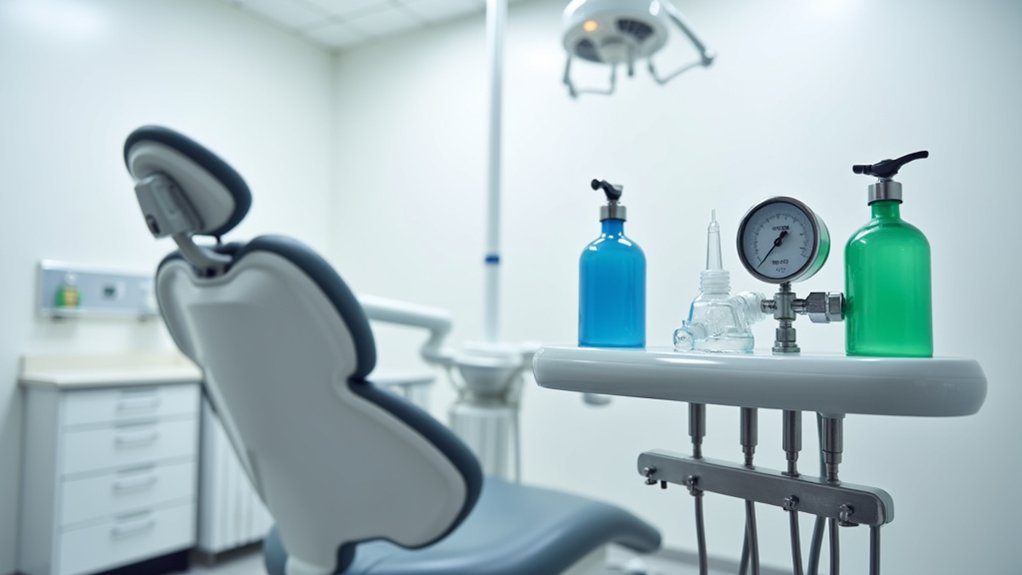Telehealth Suboxone treatment offers you greater flexibility and accessibility compared to in-person care, with research showing higher retention rates (60% vs 50% at three months). You’ll experience shorter wait times and can receive treatment from home, particularly beneficial if you live in rural areas. While both options require regular provider check-ins, telehealth demands basic technology skills and reliable internet access. Understanding these key differences will help determine which treatment approach best fits your recovery needs.
Understanding Patient Demographics in Both Treatment Models

When comparing telehealth and in-person Suboxone treatment models, distinct demographic patterns emerge across patient populations. Telehealth services tend to reach younger patients, with a considerably higher proportion of female participants around 52% across studied regions. Research shows mobile treatment units can bring care approximately 6-7 miles closer to rural patients compared to traditional facilities.
Telehealth Suboxone treatments attract a younger, predominantly female demographic, reshaping traditional addiction care accessibility patterns.
You’ll find racial disparities, with Black patients accessing telehealth at rates 5-12% lower than White patients. Patients receiving treatment via telemedicine initiation showed better 90-day retention rates compared to traditional in-person care.
Geographic treatment access patterns show telehealth serving more rural communities, particularly through Community-Based Outpatient Clinics (CBOCs). The psychiatric comorbidity prevalence differs between delivery models, with telehealth patients showing higher rates of depression and anxiety but lower rates of psychotic disorders and substance use disorders, including alcohol and stimulant use.
These demographic variations highlight how each treatment model may serve different patient subgroups, influencing healthcare delivery strategies and resource allocation.
Access and Convenience Comparison

Although telehealth Suboxone treatment gained widespread adoption during COVID-19, significant variations in access and convenience persist across different patient populations. You’ll find decreased wait times and improved mobility with telehealth options, particularly if you have reliable internet access and video capabilities. However, your ability to access these services may depend on your insurance coverage, geographic location, and technological resources. The study shows that 96.2 percent retention demonstrates telehealth’s effectiveness in maintaining long-term treatment engagement. Research indicates that telephone visits played a vital role in helping patients maintain access to addiction care.
Medicare patients typically experience better telehealth access compared to Medicaid beneficiaries, with initiation rates of 10.1% versus 8.4%. You’ll encounter different challenges based on your location urban areas offer more extensive telehealth infrastructure, while rural regions often rely on telephone-only options.
If you’re from underserved communities, you might face additional barriers related to internet connectivity and technology literacy, though hybrid models combining in-person and virtual care have emerged to address these gaps.
Treatment Retention and Long-Term Success Rates

Research demonstrates that you’re more likely to stay in treatment with telehealth Suboxone programs, which maintain 60% retention at three months compared to 50% for in-person care.
You’ll find particular benefits in rural settings, where telehealth eliminates travel barriers and reduces discontinuation rates to 3.8% versus 9.7% for traditional office visits. The improved accessibility of telemedicine helps overcome common barriers associated with in-person treatment visits.
Your chances of long-term success improve through telehealth’s regular virtual check-ins, with 48.3% of patients maintaining engagement at one year.
Telehealth Boosts Ongoing Care
Studies consistently demonstrate that telehealth services improve patient retention in Suboxone treatment programs compared to traditional in-person care. Research shows higher treatment adherence rates, with 56.4% of telehealth patients maintaining care at 180 days versus lower in-person rates. Long-term medication usage remains strong, with 48.3% still engaged at one year. Recent data from Kentucky and Ohio Medicaid claims revealed increased treatment retention among telehealth patients compared to in-person visits.
| Timeframe | Telehealth | In-Person |
|---|---|---|
| 90 Days | 60% retained | 28% retained |
| 180 Days | 56.4% retained | 35-41% retained |
| 365 Days | 48.3% retained | Lower rates |
You’ll find particularly strong outcomes in early treatment phases, with 75% retention at one month and 69% testing positive for buprenorphine. These results suggest telehealth effectively supports sustained recovery while improving access to crucial addiction treatment services.
Rural Patients Stay Longer
Rural patients receiving telehealth-based Suboxone treatment demonstrate remarkably higher retention rates compared to traditional in-person care, with over 60% remaining in treatment at the 3-month mark. You’ll find that medication optimization through telehealth maintains strong adherence, with buprenorphine positivity rates reaching 69% at one month and 56% at three months.
Treatment customization via telehealth particularly benefits Medicaid patients, showing retention rates comparable to commercially insured populations. The data reveals that female patients and those with prior overdose history often achieve better outcomes. While state-level variations exist, with 90-day retention ranging from 28.5% in Ohio to 45% in Kentucky, telehealth consistently matches or exceeds in-person treatment success rates. This evidence suggests that remote care effectively addresses geographic barriers while maintaining clinical standards. Specialized technology support specialists are available to help patients overcome technical barriers and ensure consistent access to virtual care sessions.
Technology Requirements and Digital Literacy
Successful telehealth Suboxone treatment requires basic equipment including a device with video capability, reliable internet connection, and HIPAA-compliant software platforms.
You’ll need to undergo a brief digital literacy assessment to determine your comfort level with technology and identify potential barriers to virtual care access. Treatment platforms must include simultaneous video and audio capabilities to meet DEA requirements for controlled substance prescribing.
Tech support resources, including step-by-step guides and on-call assistance, are available to help you navigate common connectivity issues and guarantee seamless participation in your treatment program.
Basic Equipment Setup Needs
To participate in telehealth Suboxone treatment, you’ll need specific technical equipment and digital skills that certify reliable communication with your healthcare provider. The basic hardware specifications include a device with a working camera and microphone, such as a smartphone, tablet, or computer. Your device must meet minimum technical requirements to run telehealth platforms smoothly.
Network connectivity requirements involve a stable internet connection capable of supporting real-time audio and video communication. You’ll need to install HIPAA-compliant telehealth software or apps that are compatible with your device’s operating system. These platforms should work across iOS, Android, or Windows systems. If you encounter technical difficulties, providers typically offer support resources to help troubleshoot connectivity issues and validate you can access your virtual consultations effectively. The convenience of accessing care from your home eliminates the stress of traveling to in-person clinic visits while maintaining the same quality of treatment.
Digital Skills Assessment Tools
Before starting telehealth Suboxone treatment, providers assess your digital literacy and technical capabilities through standardized evaluation tools. These assessments measure your proficiency with smartphones, computers, patient portals, and telehealth platforms using validated 5-point scales. Tools like the eHEALS framework are commonly used to evaluate patients’ readiness for digital health engagement. They also evaluate your understanding of health data privacy and ability to navigate digital healthcare resources.
Based on your assessment results, providers develop personalized digital skills development planning strategies to address any gaps. The digital assessment tools help ensure quality learning resources are properly matched to each patient’s needs. This process helps guarantee you can effectively participate in virtual appointments and manage electronic health records.
Healthcare staffing implications are considered as providers analyze workforce capabilities and training needs. The data collected helps healthcare teams optimize resource allocation and tailor their telehealth services to match patients’ technical abilities while maintaining compliance with digital health protocols.
Tech Support Access Options
Telehealth Suboxone programs offer multiple tech support access options to accommodate varying levels of digital literacy and technology resources. You’ll find 24/7 toll-free phone assistance for urgent platform issues and medication access concerns. Onsite troubleshooting staff at community tech hubs and harm reduction sites can help you navigate digital interfaces and resolve connectivity problems.
Programs provide structured support through plain-language guides and peer-led training sessions, with periodic tech updates to address emerging challenges. These technology adaptations help reach underserved communities more effectively while maintaining quality care. If you’re experiencing difficulties with video platforms or prescription portals, prescriber-facing technical assistance is available during practice hours.
For patients in rural or low-income areas with limited internet access, mobile health units and telephone-based alternatives guarantee continuous treatment access. Community partnerships offer additional technology training and troubleshooting resources when needed.
Rural Vs Urban Patient Experiences
While both rural and urban patients can benefit from Suboxone treatment, their experiences with telehealth services differ markedly due to geographical and socioeconomic factors. If you live in a rural area, you’ll likely find telehealth essential due to the severe shortage of local providers – 56% of rural counties lack buprenorphine prescribers. Among high-need counties, rural healthcare shortages disproportionately affect treatment access with 65% having limited prescribing capacity. Recent data shows that telemedicine visits increased adherence rates and reduced treatment gaps specifically among rural patients. Provider-patient collaboration through telehealth helps overcome significant transportation barriers and limited access to care.
In contrast, if you’re an urban resident, you’ll typically have more in-person treatment options due to higher provider density and established support networks. While care coordination challenges exist in both settings, rural patients often rely more heavily on telehealth due to socioeconomic factors like lower household incomes and higher unemployment rates. Regardless of location, treatment adherence rates remain similar between telehealth and in-person visits.
Medication Management and Monitoring Methods
Telehealth providers now utilize creative remote drug testing methods, including oral fluid tests and digital monitoring tools, to guarantee medication compliance and patient safety.
You’ll need to complete regular drug screenings through approved collection sites or at-home testing kits that are monitored via video supervision.
Your prescriptions undergo verification through state prescription drug monitoring programs (PDMPs) and digital platforms that track dosing schedules, helping maintain DEA compliance while enabling providers to make real-time medication adjustments. During treatment, patients participate in weekly check-ins with their clinician to evaluate medication effectiveness and address any concerns.
Remote Drug Testing Protocols
As medical care increasingly shifts to virtual platforms, remote drug testing protocols have evolved to maintain effective medication monitoring in Suboxone treatment. You’ll find that telehealth treatment logistics now incorporate multiple testing methods, including at-home drug testing kits and video-observed medication doses to verify adherence.
Your provider may mail you testing kits to complete during virtual appointments or coordinate with local laboratories for in-person screening. They’ll likely implement risk mitigation strategies like smaller prescription quantities and naloxone co-prescribing.
Treatment plans typically combine remote testing with periodic pharmacy check-ins to confirm compliance. Your specific monitoring protocol will depend on individual risk factors, with providers balancing clinical necessity against logistical barriers. This flexible approach allows for continued medication adherence monitoring while maintaining the convenience of telehealth treatment.
Prescription Verification Systems
A thorough prescription verification system forms the backbone of safe telehealth Suboxone treatment. You’ll find that providers must conduct mandatory PDMP checks during each visit to prevent medication diversion risks and monitor your prescription history across state lines. Identity verification occurs through two-factor authentication methods, helping address prescription fraud concerns.
Your prescriptions are closely monitored through digital platforms, with pharmacies following strict protocols for dispensing telehealth-ordered Suboxone. You’ll need to complete video visits for prescription renewals, and your provider will track adherence through app-based monitoring. There’s a 6-month limit on telehealth-initiated buprenorphine prescriptions, after which you’ll need in-person visits. Your pharmacy will verify your identity and flag any concerning patterns in the PDMP database.
Provider-Patient Communication Dynamics
Three key elements define the communication dynamics between providers and patients in virtual Suboxone treatment. Digital platforms enable more frequent check-ins, augmented information sharing transparency, and stronger provider-patient rapport building through multimodal communication channels. You’ll experience real-time support and monitoring through secure messaging, video conferencing, and audio consultations.
| Communication Method | Virtual Treatment | In-Person Treatment |
|---|---|---|
| Check-in Frequency | Multiple times/week | Monthly visits |
| Response Time | Minutes to hours | Days to weeks |
| Documentation | Real-time digital | Manual records |
| Support Access | 24/7 messaging | Office hours only |
This hybrid approach combines the convenience of telehealth with targeted in-person visits when necessary. You’ll benefit from automated appointment reminders, continuous progress tracking, and expedited medication adjustments through integrated electronic health records.
Cost and Insurance Considerations
Beyond the communication infrastructure, understanding the financial terrain of telehealth Suboxone treatment helps patients access care effectively. You’ll find transparent billing models that accommodate diverse insurance plans, including Medicaid, Medicare, and commercial coverage. Many providers offer custom financial plans through sliding scale fees based on your income.
If you’re insured, your out-of-pocket costs typically range from $0-$150 monthly for medication, while self-pay options for uninsured patients generally run $99-$199 monthly. Most telehealth providers accept multiple payment methods and verify insurance coverage before treatment begins. You’ll benefit from flexible payment arrangements, including periodic billing and payment plans.
For Medicaid recipients, services often come with minimal or no costs, particularly in states with established telehealth coverage like Tennessee.
Privacy and Confidentiality Aspects
Multiple layers of privacy protection safeguard your telehealth Suboxone treatment, combining federal regulations with cutting-edge technical security measures. You’ll benefit from HIPAA and 42 CFR Part 2 compliance, alongside end-to-end encryption that guarantees confidential video consultations and secure messaging.
Privacy perceptions often favor telehealth’s discretion advantages. You won’t need to visit public clinics or waiting rooms, reducing the risk of unexpected encounters. The therapeutic alliance dynamics remain strong while you maintain control of your environment, typically from home.
Digital prescriptions and flexible scheduling further bolster confidentiality by eliminating visible paper trails and conspicuous clinic visits. Technical safeguards include verified identity checks, secure data storage, and strict access controls, providing protection that matches or exceeds traditional in-person settings.
Treatment Flexibility and Scheduling Options
Building on the secure telehealth foundation, treatment flexibility emerges as a significant advantage for patients seeking Suboxone care. You’ll find that telehealth appointments offer customized scheduling options beyond traditional office hours, with data showing improved attendance rates of 91.7% compared to 74.1% for in-person visits. The elimination of travel time makes treatment more accessible, especially if you’re managing work or caregiving responsibilities.
Your treatment plan can include personalized follow-up support through hybrid models that combine virtual visits with occasional in-person checks. This flexibility has proven effective, with retention rates reaching 68% at 90 days compared to 42.9% pre-pandemic. You’ll benefit from reduced logistical barriers and the ability to maintain consistent care through remote access, particularly valuable if you’re in underserved or rural areas.
Frequently Asked Questions
Can Patients Switch Between Telehealth and In-Person Suboxone Treatment When Needed?
Yes, you can switch between telehealth and in-person Suboxone treatment when clinically appropriate. Treatment programs often offer scheduling flexibility, allowing you to move between virtual and physical appointments based on your needs while maintaining care continuity.
Research shows that hybrid models work effectively, with patients successfully receiving treatment through both modalities within the same healthcare system. However, you’ll need to comply with current regulations and follow your provider’s clinical recommendations for any treatment changes.
What Happens if There’s an Emergency During a Virtual Suboxone Appointment?
If you experience an emergency during a virtual Suboxone appointment, your provider will activate emergency response protocols immediately. They’ll assess your symptoms’ severity and can direct you to the nearest ER if needed.
While clinical oversight concerns exist with virtual care, providers can contact emergency services on your behalf, coordinate with local hospitals, and connect you to SAMHSA’s 24/7 helpline. You’ll also receive guidance for immediate follow-up care.
How Are Drug Screening Tests Conducted for Telehealth Suboxone Patients?
For your telehealth Suboxone treatment, you’ll participate in remote monitoring requirements through either Video Drug Screening (VDS) or Automated Drug Screening (ADS).
You’ll receive test kits at home and follow medication adherence protocols by collecting urine samples according to structured guidelines.
With VDS, you’ll review results live with your provider, while ADS allows you to submit photographic evidence through an app.
Both methods effectively verify prescribed medication use and detect potential substance concerns.
Do Telehealth Suboxone Providers Offer After-Hours Support or Crisis Intervention?
Most telehealth Suboxone providers offer 24/7 telephone support through crisis hotlines and peer specialists. You’ll typically have access to on-call providers for urgent medication concerns, though non-emergency medication adjustments require scheduled appointments.
While immediate video consultations aren’t always available after hours, you can connect with SAMHSA’s National Helpline for crisis intervention. Some programs like Boulder Care provide round-the-clock peer support to complement your regular treatment schedule.
Can Family Members Participate in Virtual Suboxone Treatment Sessions?
Yes, you can include family members in your virtual Suboxone treatment sessions. Many providers encourage family support during sessions to strengthen your recovery path.
Your loved ones can participate through secure video platforms while maintaining privacy concerns for virtual care. You’ll have flexibility in choosing when and how to involve family members, whether it’s during individual counseling or group therapy sessions.
Treatment plans can be customized to include appropriate family participation levels.






